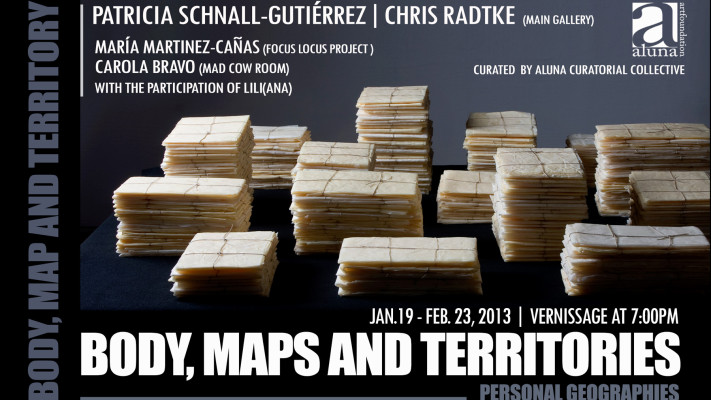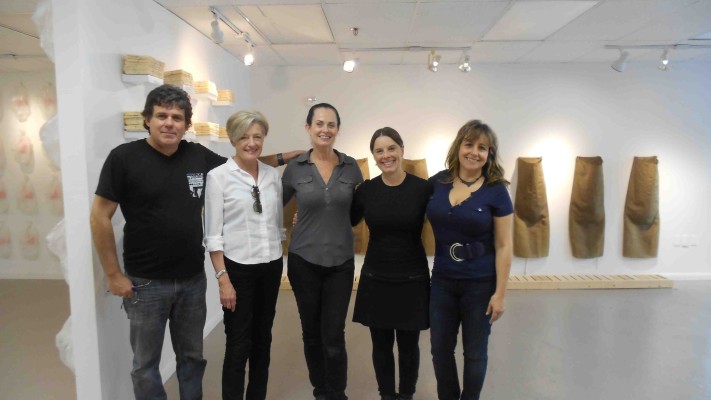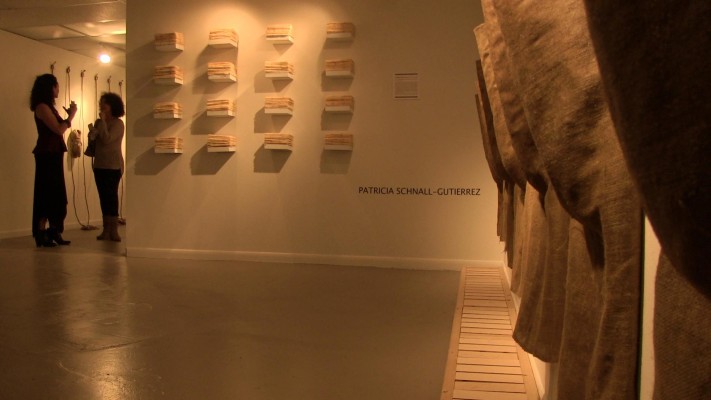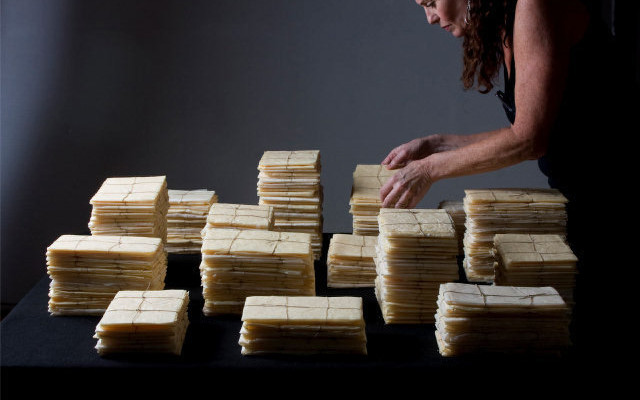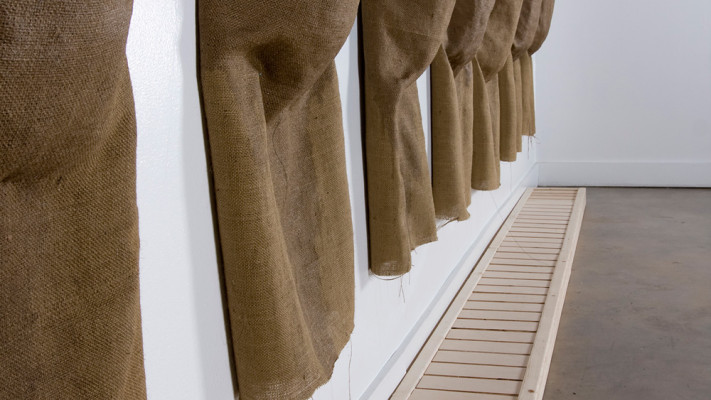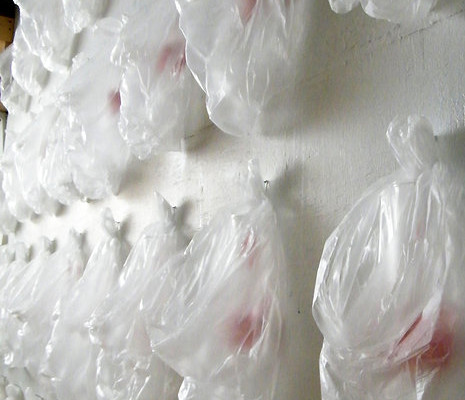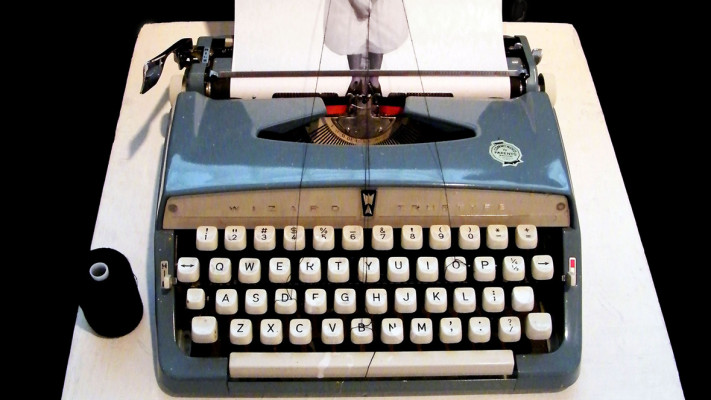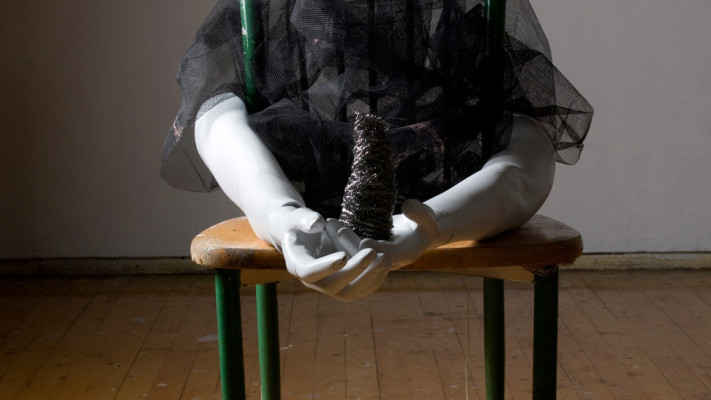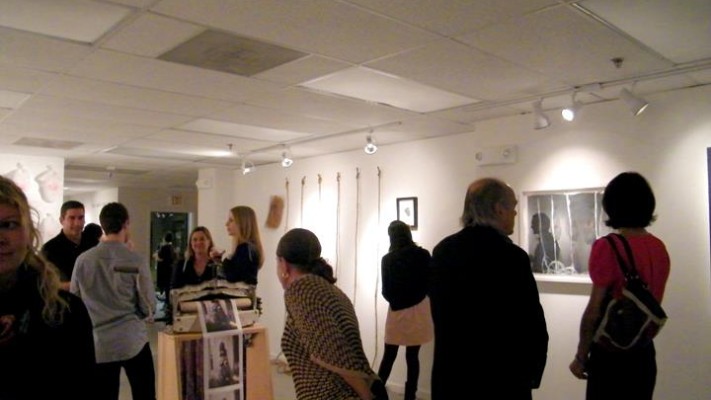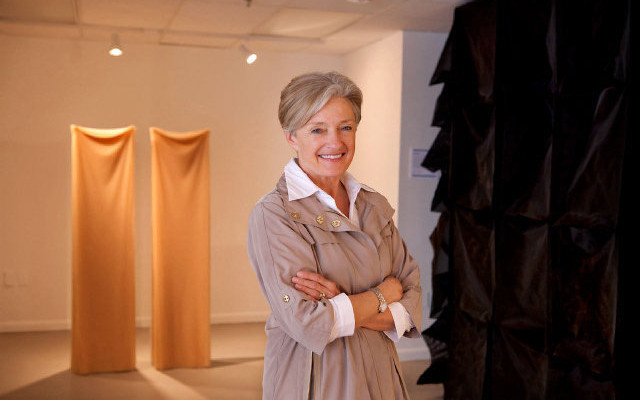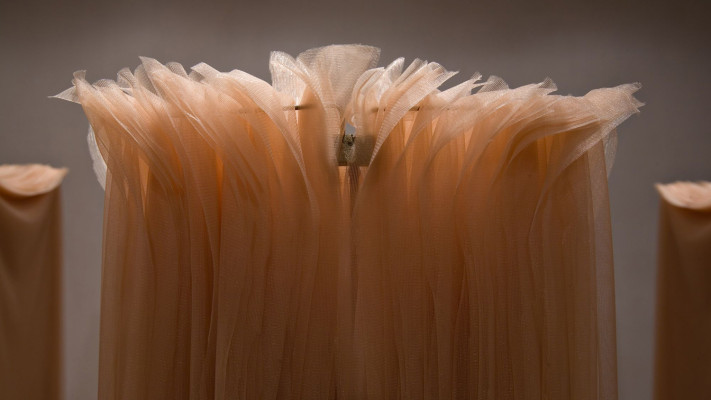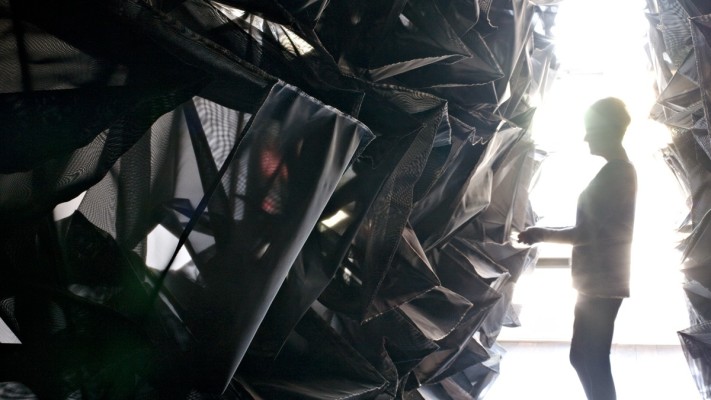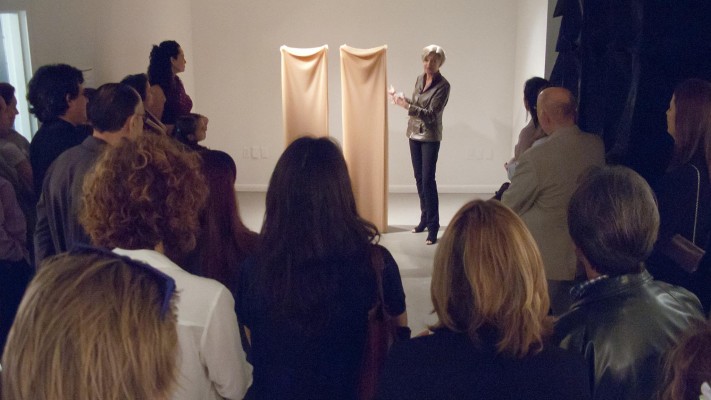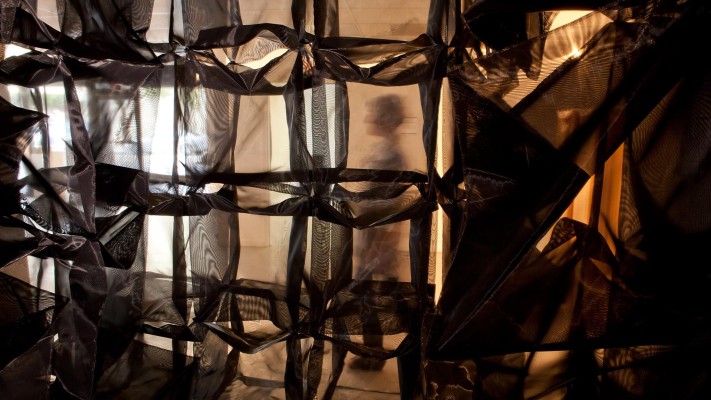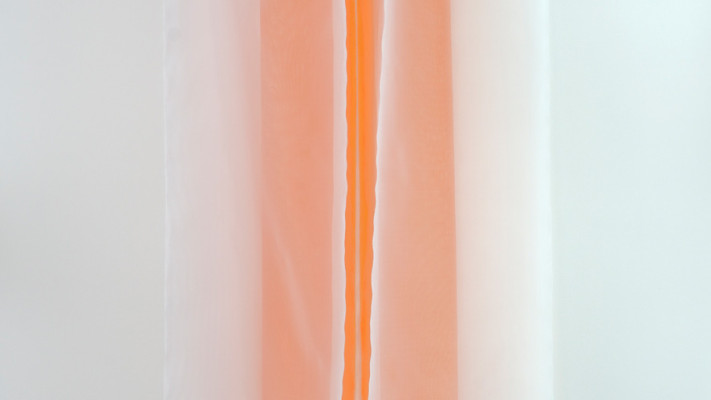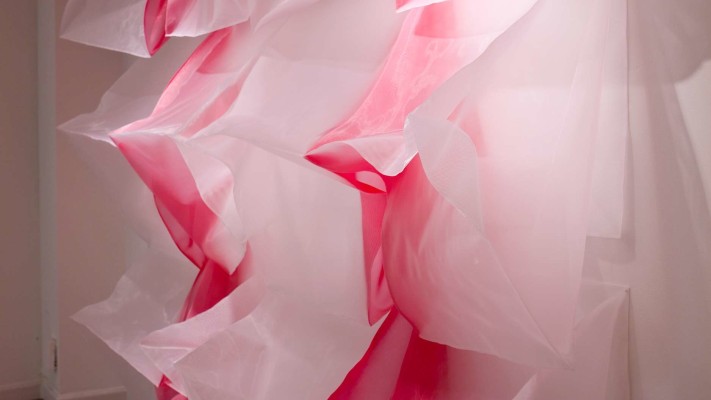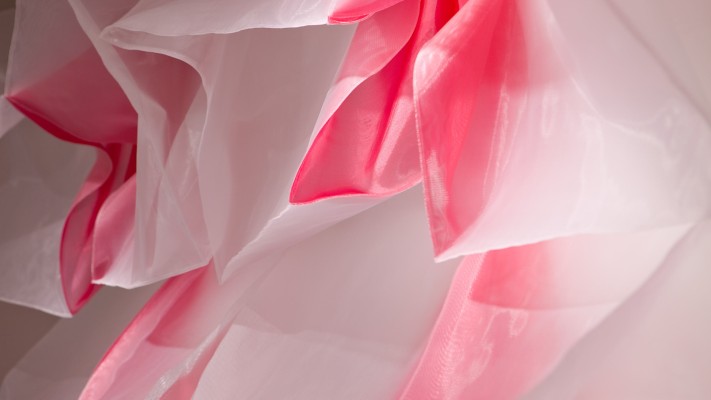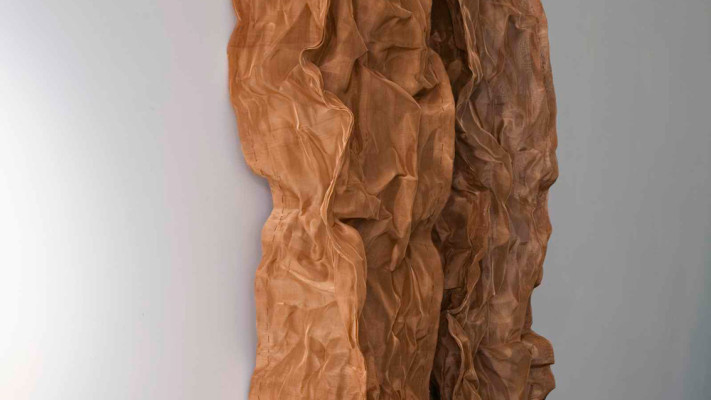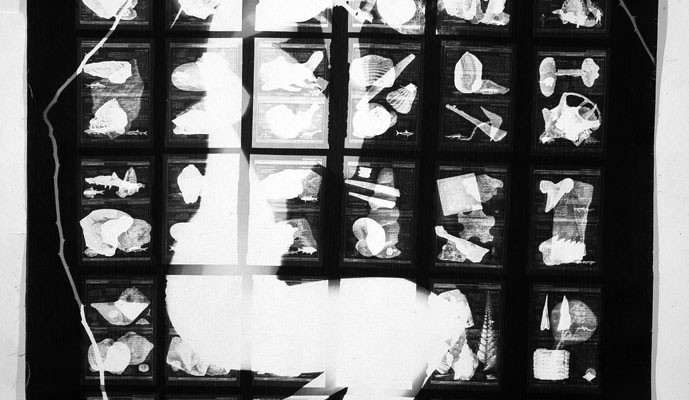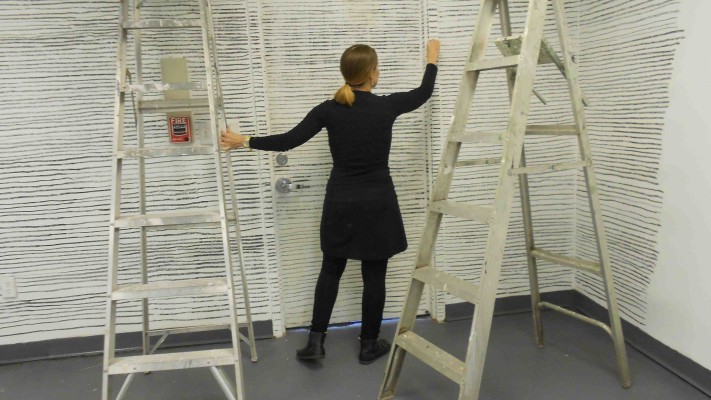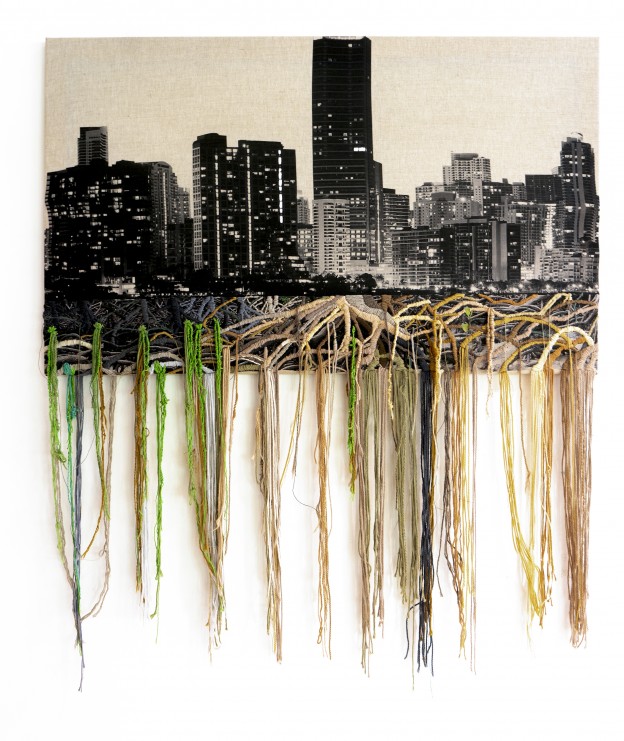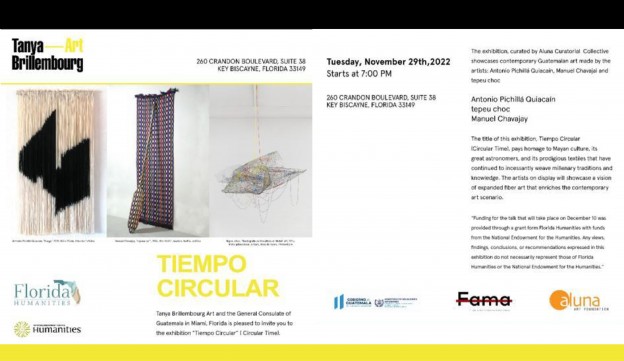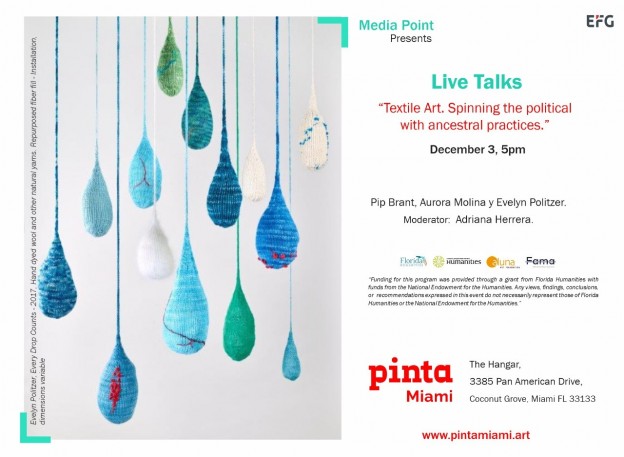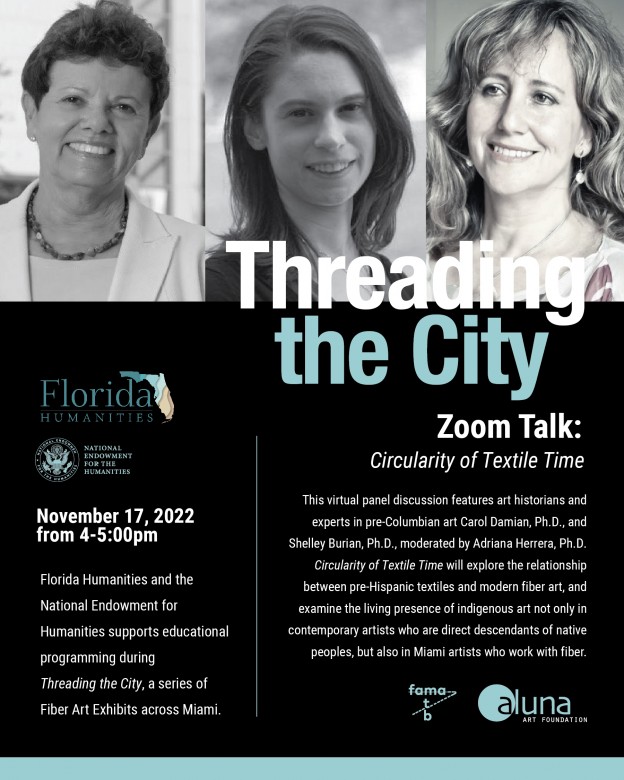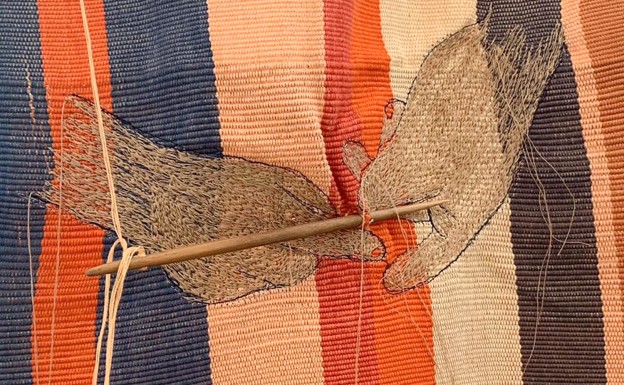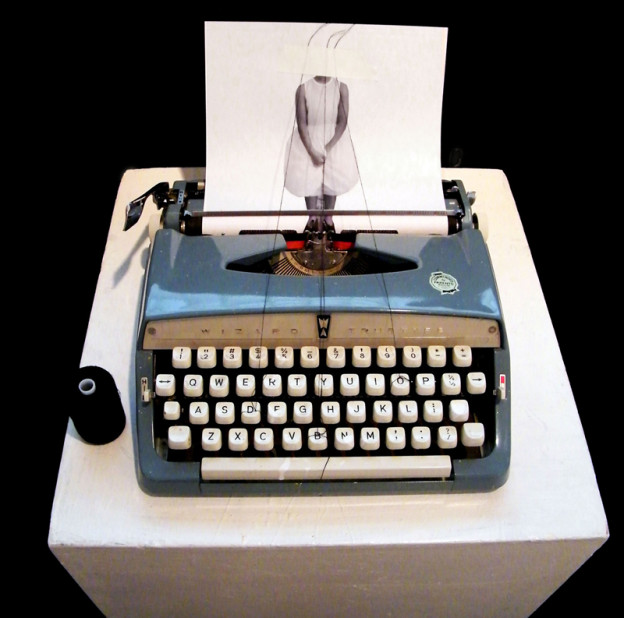
Body, Maps and Territories: Personal Geographies
Patricia Schnall-Gutierrez & Chris Radtke; with the special projects of Maria Martinez-Cañas and Carola Bravo
Curated by Aluna Curatorial Collective
From January 19th February 23th, 2013 at Aluna Art Foundation
Body, Maps and Territories
By Aluna Curatorial Collective
The history of the representation of the body by women artists broadened its scope in the 20th century. Her self-representation responds now to a search based on her own gaze, which thus had gradually colonized alternate routes of access, not only to the redefinition of female identity —linked to the reflectivity of her artistic process—, but to ontological notions of us as human beings in construction.
In that passage from the territory of the female body as another’s object to the body as its own subject, representing themselves, the maps charted by women artists become forms of representation “contaminated” by the presence of life. There are maps drafted on the borders between reality and representation, transformed along the journey, in such a way that nobody can look down at these maps without glimpsing some reflection of the personal geographies, even though they even though they also refer to known places in the history of art.
“Body, Maps, and Territories: Personal Geographies” reconnects with that crucial expressionist alternative opposing cold minimalism, which was inaugurated by “Eccentric Abstraction”, the historical exhibition curated by Lucy Lippard in 1966, in New York. In a way, it reflects the long-standing validity of the influence of post-minimalism, which had then reconnected art and life through the work of artists such as Eva Hess, Louise Bourgeois and Yayoi Kusama.
Patricia Schnall Gutiérrez and Chris Radtke address the representation of the body through different explorations that update in diverse ways the legacy of minimalist and post-minimalist antecessors, taking advantage of the vast referential liberty of post-modernity —from Vanessa Beecroft, to Do-Ho Suh, or Helen Chadwick— to propose, each in their own way, explorations of the self linked to their deepest being.
Schnall chooses the found objects she incorporates in her installations based on their association with life and their clear connection with the feminine. In this way she eliminates the separation not only between common objects in general and art, but between the specific world of the domestic and the exhibition space.
In several cases, such as in the installations Body Language and Inheritance, made with antique machines, she assigns to found objects a key function: she makes them appear —through the insertion of photographs or photocopies— as kinds of image-producing machines that put in crisis the iconography with which, during her teen years −in the late 1960s− the roles of woman were still being defined.
Schnall, who uses materials and conceptual keys of her own to explore the relation between autobiography and representation, and between the gaze on the body and feminine identity, strengthens awareness of the fact that the ontology of the woman of the third millennium is undergoing a transition towards new modes of recognition.
Starting from a projection of the sense of corporality, which links one to another in the chain of life, and using her body as a measure for scale, Radtke creates installations that are kind of organic —changing over time and with different environments— with mesh cubes. These mesh cubes are presented in pairs as an allusion to the DNA contained in the chromosomes that make unique each being. Her installations become metaphors for the living body that not only respond to the environment, but also contain subtle references to sexuality and the passage of time.
In an abstract and almost poetic way, she places in the interior of some white, translucent cubes delicate forms that, with their intense colors —tones of reddish, orange or pink— resemble the feminine sex. If the cubes are a metaphor for the body as a being of light, those colored parts are connected to the pulse of life on earth, the erotic impulse, in a harmonic way that reunites the human spirit and the flesh as an image of total beauty. In her installations, the walls of the space also become jointed with the “skin” of her pieces outlining maps or alternative path structures that infuse life to the exhibition space, reminding us that each part is connected to the other: the transformation is constant and every change affects the totality.
The black labyrinth that she constructed needs to be opened and explored by the body of the spectators that are called to go inside the piece and activate it trough his/her own corporal presence. It is in the experience of the body that one can understand that we are the part needed to complete her art and its vision about the ultimate unity of all beings.
For her part, Carola Bravo confronts the dilemma between maps and representation, playing —as she does in the experimental Mad Cow room— with the duplication of real space and with presence-absence exercises with her own body, which spectators think they see when it is not really there. In this exhibition —as well as in those maps that she traces using the patterns of marvel or intervening floors and walls as imaginary appropriations of the spaces in the world— there is a poetic of the abyss that plays with the passing of time while setting up doubt between what we think we see and what is actually there. This interregnum between known and invented geography makes way in all cases to an awakening of possibilities for a territory of crossings between the intimate and the collective demand for the space that we wish to transit.
Parallel to this, in the Focus Locus Project room, María Martínez-Cañas presents works from the series Flight (Hospital Bed), which originates in her having accompanied a close friend through his agony and visiting the posthumous exhibition of Carlos Alfonzo. Exorcizing the marking of death on the bodies of her friends, while at the same time covering hers with a blanket, she makes frames that expose the nudity of her naked body in the amplifier recombining it with leaves and seeds. The resulting images gives a new life to the body which, by being permanently fixed into the fabric, rescues in its own form the shape of the body of her lost friends. The fragmented images are the multiplied presence, and not only a ritual vision of resurrection, but also a memory that embraces the alteration of the body itself. Each of us, it seems to remind us, is the other, and we are born and die together.
By going over maps constructed using the feminine body itself —maps which can blur the roles that others have outlined—; by projecting their condition of change through time via an image of unity with the universe; by inventing alternative cartographies that each person reads with their own key; and by assuming the death of others as your own, wishing to bring them back to life; we are faced with the possibility of new ontologies, from which it is possible to re-imagine the geographies of the life we all share.
Mapas abstractos: territorios del cuerpo femenino
Por Aluna Curatorial Collective
La historia de la representación del cuerpo femenino hecha por artistas mujeres, amplió radicalmente su campo de representación en el siglo XX. El territorio del deseo masculino había configurado un imaginario visual asociado a la noción de belleza y al desnudo femenino construido desde los ojos del otro, según los cambiantes parámetros externos de las eras. En cambio, la historia de la auto-representación del cuerpo de la mujer responde más a una búsqueda ontológica emprendida desde la propia mirada que de este modo fue colonizando otras vías de acceso a sí misma, estrechamente ligadas a la experiencia existencial.
En ese paso del territorio del cuerpo femenino como objeto al cuerpo como sujeto de sí mismo, los mapas trazados por las artistas se convierten en formas de representación “contaminadas” por la presencia con la vida. Son mapas trazados en las fronteras entre realidad y representación, transformados a lo largo del recorrido de tal modo que nadie puede inclinarse sobre éstos sin vislumbrar algún reflejo de las geografías personales, incluso de la autobiografía, aunque asuman la construcción de lenguajes en un diálogo con la historia del arte. De hecho, Cuerpo, mapa y territorio: geografías personales, se reconecta con la crucial alternativa expresionista ante el frío minimalismo que abrió “Eccentric Abstraction”, la histórica exhibición curada por Luccy Lippard en 1966 en Nueva York. De algún modo refleja la vigencia del influjo del posminimalismo que entonces reconectó arte y vida a través de la obra de artistas como Eva Hesse, Louise Bourgoise y Yayoi Kusama[1].
Aluna Art Foundation presenta en la galería central la obra de dos artistas, Patricia Schnall Gutiérrez y Chris Radtke, quienes abordan la representación del cuerpo a partir de exploraciones que reactualizan de diversas maneras el legado postminimalista y aprovechan la vasta libertad referencial de la posmodernidad, para proponer, cada una a su modo, visiones que eluden de modo consciente el simulacro. Partiendo de diversas estrategias de reconocimiento afianzadas en el cuerpo femenino esbozan en efecto, proposiciones relacionadas con la construcción de una verdad pronunciada por sus cuerpos.
Schnall lo hace explorando los roles atribuidos a la mujer y subvirtiendo el valor de uso de los objetos que suelen rodearla en el reino de lo doméstico –con materiales como bolsas de basura, esponjillas, máquinas de lavar, cartas doladas y atadas como paquetes que son sucedáneos de las labores repetitivas de la casa. Al emplearlos como ready-mades no sólo inserta los objetos del hogar en el espacio expositivo, sino que puede incluso convertirlos en recursos productores de un nuevo imaginario, espejos de una identidad en construcción para la mujer del tercer milenio.
Chris Radtke usa como punto de partida las dimensiones de su cuerpo en instalaciones que también recurren al empleo minimalista de la geometría repetitiva, pero las instala de tal modo que les transfiere un sentido tácito de organicidad. Como el cuerpo vivo, las cajas de malla de nylon —que conforman pasadizos para la interacción con el espectador—, o las telas translúcidas —que contienen en su interior formas asociadas a la pulsión sensual de lo más íntimo—, se transforman a lo largo de los días con las condiciones ambientales o con la gravedad. El espacio expositivo no es neutral ni incontaminado por la vida: las partes de cada instalación se interrelacionan en estructuras sujetas a cambios, que ocurren a través de los días, y en las cuales la transformación de cada parte afecta al todo. Ambas propuestas des-ficcionalizan el cuerpo femenino imaginado por la mirada del otro: Schnall lo hace subvirtiendo los roles sobrepuestos a éste, recurriendo a prácticas liberadoras como construir –con materiales como esponjillas de limpieza metálicas- una obra abstracta tridimensional que evoca, ya sin carga social alguna, la sinuosidad del cuerpo femenino. Radkte construye una instalación abstracta a partir de las dimensiones de su propio cuerpo, de modo que la estructura revela la unidad esencial de cuanto existe, y sugiere un umbral de trascendencia.
Por su parte, Carola Bravo se enfrenta al dilema entre mapa y representación, jugando –como lo hace en la sala experimental Mad Cow- con la duplicación del espacio real y con ejercicios de presencia-ausencia de su propio cuerpo, que el espectador cree ver cuando realmente no está. Tanto en esta instalación como en esos mapas que traza aprovechando las vetas del mármol o interviniendo suelos y paredes como apropiaciones fantásticas del espacio del mundo, hay una poética del vacío que detiene el tiempo al instaurar una duda entre lo que creemos ver y lo que está. Ese interregno entre la geografía conocida y la inventada abre paso en todos los casos a un despertar de posibilidades y a un territorio de cruces entre lo más íntimo y la pregunta colectiva por el espacio que deseamos transitar.
Al recorrer los mapas construidos a partir del propio cuerpo femenino que desdibuja los roles que otros han trazado sobre sí, o que proyecta su condición de cambio en el tiempo desde una imagen de unidad con el universo, o que inventa mapas alternos para sí que cada quien lee en clave propia, estamos ante la posibilidad de nuevas ontologías como las que estas mujeres artistas crean: el cuerpo femenino como mapa y territorio donde es posible reimaginar geografías de la vida en común.



